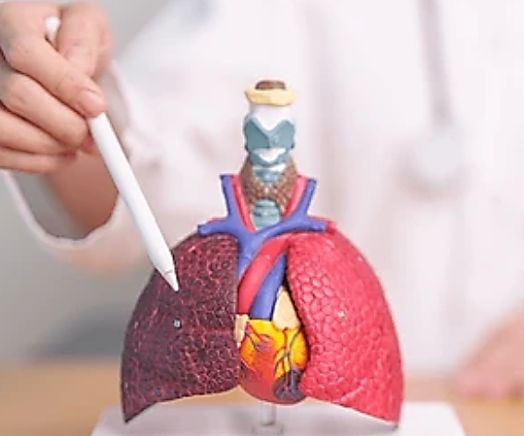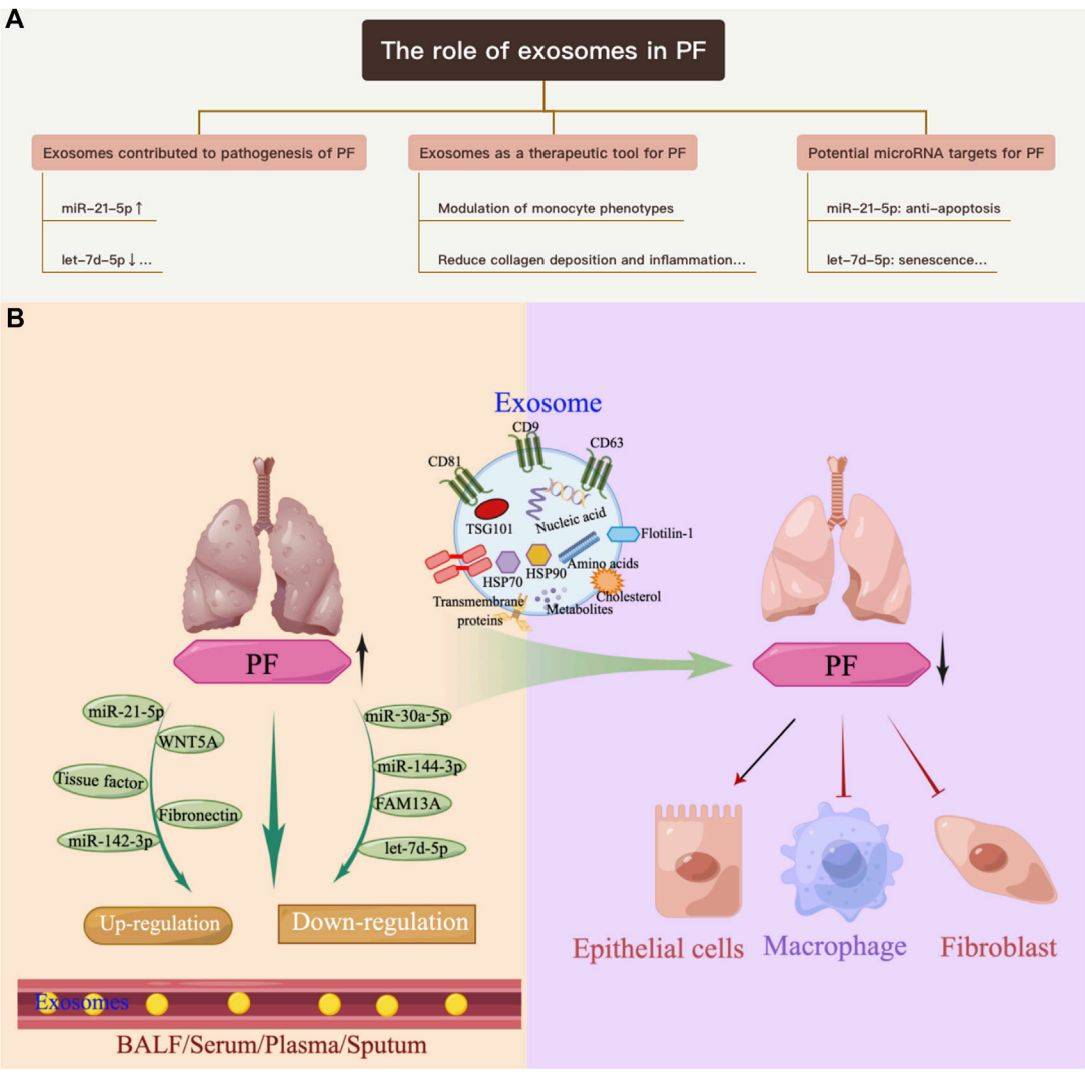Exosome Research in Human Pulmonary Fibrosis

Pulmonary fibrosis (PF) is a persistent progressive, diffuse lung disease that mainly involves the interstitium of the lungs and has an irreversible course, seriously jeopardizing human life and health. Although some progress has been made in the research on the pathogenesis and treatment of PF, there is no effective treatment other than lung transplantation available, thus there is an urgent need to find more effective treatments.
Exosomes are microscopic nanoscale extracellular vesicles that can be released by almost all types of cells and are crucial for intercellular communication, immunomodulation, inflammation, and cellular phenotypic transformation and play an important role in PF. By elucidating the role of exosomes in the pathogenesis of PF, it will provide new biomarkers for the diagnosis and prognosis of PF, as well as shed light on the search for new therapeutic approaches.
Why are Exosomes used in the Diagnosis and Treatment of PF?
The exact pathogenesis of PF is unclear and there is a lack of effective treatments, with a poor prognosis and a median survival of only 3-5 years from diagnosis. Although two therapeutic agents (pirfenidone and nintedanib) can slow the rate of lung function decline, they are not curative and have significant gastrointestinal side effects. Lung transplantation, as a radical treatment, improves patient survival, but challenges such as donor organ shortage, immune rejection, and surgical complications remain. Therefore, PF requires more efficient biomarkers and therapeutic modalities to improve early diagnosis and treatment outcomes for patients. Exosomes are critical for intercellular communication, immune response, immunomodulation, inflammation, and cellular phenotypic transformation and play an important role in PF. In addition, the number and characteristics of exosomes change according to the pathophysiological state of the disease, and therefore exosomes can be used as biomarkers for monitoring the disease.
Mechanisms of exosomal regulation of PF
Increasing evidence suggests that exosomal transported miRNAs can be involved in the PF process by modulating fibrosis-related cellular functions and expression of target proteins, as well as regulating inflammatory immune signaling pathways.
 Figure 1. The role of exosomes in PF. (Yang Y, et al., 2019)
Figure 1. The role of exosomes in PF. (Yang Y, et al., 2019)
- Exosome Regulation of Epithelial-Mesenchymal Cell Transdifferentiation
Epithelial-mesenchymal cell transdifferentiation (EMT) is the cytological basis for the occurrence of malignancy, organ fibrosis, and wound healing. The EMT process is very important in interstitial fibrogenesis of the lungs, which is a hot spot in the study of the pathogenesis of PF. Transcriptomics studies have demonstrated that exosome-derived miRNAs play a potential and powerful gene regulatory function in the pathogenesis of lung diseases such as PM2.5-induced PF and lung cancer. For example, elevated levels of miR-142-3p in exosomes may lead to a shift in the homeostatic relationship between mesenchymal cell proliferation and differentiation, a shift that is also an important feature in the progression of PF.
- Exosome Regulation of Fibroblast Proliferation and Collagen Production
Lung tissue fibrosis is characterized by an imbalance in extracellular matrix (ECM) metabolism leading to massive overdeposition of collagen, which is commonly accompanied by a marked upregulation of the fibrogenic factor TGF-β. Some investigators have found in a rat bleomycin-induced PF model that the upregulated M2-type macrophage-derived exosome miR-328 can accelerate PF disease progression by targeting negative regulation of FAM13A gene expression to promote the proliferation of interstitial lung fibroblasts, and by increasing the expression of collagen 1A, collagen 3A, and α-SMA.
- Exosome Regulation of Macrophage Polarization and Activation Processes
Inflammatory cells also play an important role in the PF process as they are involved in the early normal healing of wounds. Macrophages are central regulatory cells in PF. Mature macrophages are capable of exhibiting phenotypic and functional differentiation induced by multiple factors, i.e., polarization phenomenon, which has an important role in the immunopathological process of various diseases. For example, LPS-pretreated MSCs can regulate macrophage polarization through exosome delivery of let-7b, which in turn can inhibit chronic inflammatory responses to promote wound healing.
- Exosome Regulation of Lung Tissue Cell Injury and Senescence
Damage and abnormal repair of alveolar epithelial cells (AECs) are also important mechanisms leading to PF. It has been found that exosomes secreted by endothelial precursor cells (EPCs) can attenuate LPS-induced acute lung injury in mice by specifically transporting miR-126 molecules. In addition, MSCs-derived exosomes can provide a protective function for acute lung injury disease through the regulatory role of miR-30b-3p, inhibit the expression level of serum amyloid 3 (SAA3), and thus alleviate LPS-induced cellular injury in lung tissues of type II AECs.
Research on Exosomes in PF Therapy
Intervention studies using cell-secreted exosomal miRNAs in tissue fibrosis diseases have been reported extensively over the years. It has been reported that the use of exosomal miRNAs derived from MSCs can affect the prognosis of fibrotic diseases. For example, miR-181-5p-modified exosomes derived from adipose-derived mesenchymal stem cells (ADSCs) can inhibit the fibrotic process of liver tissues by activating the autophagy signaling pathway. Treatment with exosomes derived from human bone marrow mesenchymal stem cells (BMSCs) attenuated experimental silica dust-induced PF injury. Among them, exosomal miR-451 plays an important role in the regulation of macrophage activity. In addition, intratracheal injection treatment of PF mice using exosomes derived from ADSCs can significantly reduce the degree of PF in terms of collagen fiber content, granuloma size of lung tissues, macrophage number in alveoli, and IL-1β and TGF-β levels in lung tissues.
 Figure 2. Therapeutic potential of BMSC-derived exosomes for PF. (Xie L, Zeng Y., 2020)
Figure 2. Therapeutic potential of BMSC-derived exosomes for PF. (Xie L, Zeng Y., 2020)
Exosomes in the Diagnosis and Prognosis of PF
In addition to stem cell exosomes, studies of other sources of exosomes in PF have been reported. In bronchoalveolar lavage fluid from patients with idiopathic PF (IPF), the level of exosome-derived miR-30a was negatively correlated with the degree of fibrosis, suggesting that it could be used as a prognostic biomarker for IPF disease. Also in vitro experiments have demonstrated that overexpression of this miRNA molecule reduces the expression of TGF-β and α-smooth muscle proteins in lung epithelial A549 cells, suggesting that it can slow down the progression of PF. In addition, some cellular experiments revealed that miR-1343 could be transported into lung epithelial cells by exosomal packaging of HL-60 cells and alleviated the process of PF by inhibiting the TGF-β signaling pathway, which suggests that miR-1343 could be a new target molecule for the treatment of PF disease.
Our Services and Products
As nanoscale extracellular vesicles carrying inclusions such as proteins, nucleic acids, and lipids, exosomes play an important role in intercellular communication in the complex pathological and physiological networks of the human body.
Creative Biostructure has mastered highly specific exosome enrichment and isolation techniques and highly sensitive exosome characterization and analysis methods to help clients explore the potential of exosomes in the diagnosis and treatment of PF. If you have any questions, please feel free to contact us.
| Cat No. | Product Name | Source |
| Exo-HDBF-12 | HQExo™ Exosome-SDH-Pulmonary Fibrosis plasma | Exosome derived from Single Donor Human Pulmonary Fibrosis plasma |
| Exo-SC01 | HQExo™ Exosome-PCS-500-011 | Exosome derived from human pre-adipose derived mesenchymal stem cell (PCS-500-011) |
| Exo-SC03 | HQExo™ Exosome-hTERT | Exosome derived from hTERT-immortalized Mesenchymal Stem Cell |
| Exo-SC04 | HQExo™ Exosome-MSC | Exosome derived from Xeno-Free Human Mesenchymal Stem/Stromal Cells and Media |
| Exo-SC02-1 | HQExo™ Exosome-PCS-500-012 | Exosome derived from human bone marrow-derived mesenchymal stem cell line (PCS-500-012) |
| Exo-SC02-2 | HQExo™ Exosome-Pla-MSC | Exosome derived from human placental derived mesenchymal stem cell |
| Explore All Exosome Products | ||
References
- Yang Y, et al. Roles of exosomes and exosome-derived miRNAs in pulmonary fibrosis. Front Pharmacol. 2022. 13: 928933.
- Xie L, Zeng Y. Therapeutic Potential of Exosomes in Pulmonary Fibrosis. Front Pharmacol. 2020. 11: 590972.
